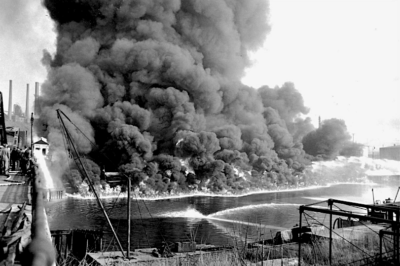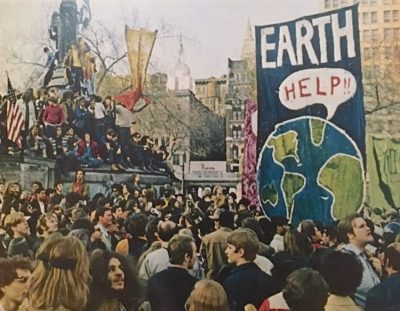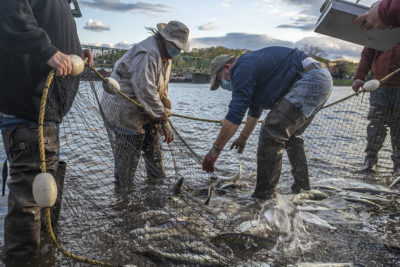When Steve Meserve’s great-grandfather, Invoice Lewis, began the Lewis Fishery in 1888, it was one among dozens of economic outfits scattered up and down the Delaware River that seined for American shad through the spring spawn. On the time, the Delaware’s shad fishery hauled 3 to 4 million of the hard-fighting fish from the river and its tributaries yearly. However, quickly sufficient, Lewis found that he had gotten into the enterprise simply because the river — together with the species it supported — was coming into a interval of catastrophic decline.
For 2 centuries, factories and cities on either side of the Delaware had been indiscriminately dumping trash, uncooked sewage, and industrial chemical compounds into the waterway. “My grandfather, Fred, would joke that we’d catch a automotive a 12 months with all of the elements that turned up within the nets,” stated Meserve, who took over the household fishery in 1996. “And in my youth, within the 60s, there have been extra jokes about getting sick by swimming within the river and consuming the water.”
The Lewis Fishery was situated in Lambertville, New Jersey, not far upriver from what got here to be generally known as the “useless zone,” a 27-mile city stretch of the Delaware, between Philadelphia and Chester, Pennsylvania, the place level supply air pollution was so acute that the water’s dissolved oxygen (DO) ranges have been typically zero. Sturdy DO content material was essential to the survival of the shad, in addition to different aquatic species like sturgeon, striped bass, and oysters. The useless zone successfully rendered their capacity to maneuver upriver not possible — and made any direct human contact with the river harmful.
The Clear Water Act offered the federal government with the authorized framework to manage air pollution and the funding to wash it up.
However, simply as Meserve was studying tips on how to set and haul shad nets as a boy within the Nineteen Sixties, a historic intervention was within the making. Sparked by the burgeoning environmental motion, the federal authorities started passing a collection of legal guidelines that will assist convey the Delaware again from the brink, in addition to the estimated two-thirds of U.S. rivers, lakes, and coastal waters that had additionally change into so poisonous they have been unsafe for fishing and swimming. Chief amongst this string of key environmental laws was the landmark Clear Water Act of 1972, which was enacted 50 years in the past this month. The act offered the federal authorities, for the primary time, with the authorized framework to manage air pollution and the funding to assist states construct wastewater infrastructure that will result in the speedy enchancment of water high quality within the Delaware and within the scores of different water our bodies that had change into the waste receptacles of the Industrial Revolution.
“On the time, as a rustic, we have been past simply trying to attempt to put meals in our mouths and roofs over our heads, and searching for higher issues in life, which environmental high quality is one among them,” stated G. Tracy Mehan, a former affiliate deputy administrator of the U.S. Environmental Safety Company. “All of it mixed with energetic political advocacy that yielded the raft of environmental legal guidelines which might be nonetheless just about guiding our regulatory insurance policies at this time.”
The Delaware River runs 330 miles. From two separate headwaters in New York, it follows the worn Devonian contours of the Catskill Mountains, gathering quantity and velocity earlier than combining to form a course that types the quivering fringe of Pennsylvania’s northeast border. When William Penn first sailed up the river, in 1682, its contemporary water ran clear as gin all the best way to the briny Delaware Bay. For eons prior, and thru hundreds of years of Native American settlement, the watershed had functioned with out impairment, naturally constructing and nourishing the wealthy biodiversity that Penn and future European settlers would want to outlive.

CLICK TO ENLARGE. The Delaware River watershed.
Shannon1 through Wikipedia
In actual fact, it was the vitality of the watershed that struck Penn most in his seek for the placement of a “nice Towne” in “ye most handy place upon the River for well being and Navigation.” He wrote with awe in regards to the river’s extraordinary ecology: oysters six inches lengthy and bigger, their reefs blanketing the riverbed; Atlantic sturgeon, some as massive as 14 toes and as heavy as 800 kilos, breaching in all places in explosive, playful leaps. Shad swimming in colleges as thick as wool.
Little greater than 50 years after Penn’s arrival, Philadelphia’s banks have been studded with tanneries and slaughterhouses whose byproducts left the Delaware opaque and foul. In 1739, 33-year-old Benjamin Franklin and his neighbors petitioned Pennsylvania’s normal meeting to take away the polluters from the riverbank. Within the sweltering summer time of 1776, as delegates from the colonies gathered to draft the Declaration of Independence, most of the metropolis’s streets have been piled with rotting rubbish and manure that ended up within the river.
By the late 19th century, Philadelphia’s inhabitants was round 1 million; close by cities, like Camden, New Jersey, have been additionally quickly rising. Whereas consuming water requirements had improved by then, the Delaware, together with the nation’s different nice rivers, had change into untouchable voids — open, putrid secrets and techniques of the American experiment. Shad fisherman Invoice Lewis saved meticulous catch logs, a convention that his descendants maintained. “Our data present how unhealthy the decline in fish numbers was,” Steve Meserve stated. “We have now a few years with single or very low double digits — now we have two years the place we didn’t catch any shad in any respect.”
Within the Seventies, Gerald Kauffman was a highschool child residing in Pennsauken, New Jersey, a blue-collar neighborhood throughout the Delaware from Philadelphia, the place tree-lined streets gave approach to a riverbank lined with petrochemical vegetation and warehouses. “Rising up on the river, it simply had a stench,” Kauffman, who at this time is the director of the College of Delaware’s Water Assets Heart, stated. “We’d pull fish out of the river that have been coated with oil.”
Sailors on the Philadelphia Navy Yard have been unable to sleep of their berths due to rancid fumes belching from the water.
In a paper recounting the historical past of water high quality within the river, Kauffman writes that the home effort within the World Battle II period metastasized the Delaware’s air pollution woes. Chemical firms like DuPont have been manufacturing every thing from dynamite to novel compounds like plastics polymers, polychlorinated biphenyl (PCB), and per- and polyfluoroalkyl (PFAS) compounds. The byproducts typically made their method into mixed sewage techniques together with uncooked sewage or have been launched immediately into the river and its tributaries.
In some locations round Philadelphia, Kauffman notes, sludge sat 12 toes thick on the river backside. Sailors on the Philadelphia Navy Yard have been unable to sleep of their berths due to the rancid fumes belching from the water. The contemporary coat of paint on a hospital ship “became the colours of a rainbow because it sailed out into the poisonous Delaware River.” The circumstances turned so dire that, in 1941, President Roosevelt ordered an investigation of the impacts of the air pollution on the army effort. In 1944, James Allen, a regional water official, advised the Philadelphia Inquirer that, if one thing wasn’t achieved instantly to quell the air pollution dumped from Philadelphia and Camden, “after this warfare is over there’s a hazard that they could change into ‘ghost’ ports.”
Allen was hardly alone in his sense of urgency. Throughout the U.S., policymakers and unusual residents alike have been waking as much as the dire state of America’s waterways and shorelines. In 1948, Congress tried to deal with the issue by passing the Federal Water Air pollution Management Act. However the invoice afforded the federal government too little regulatory energy or funding to power states and business to quell level supply discharges from sewage vegetation and factories, the first reason behind river air pollution by an order of magnitude.

The Cuyahoga River on hearth in 1952.
The Cleveland Press Assortment / Cleveland State College
With the daybreak of the Nineteen Sixties, nonetheless, the disparate makes an attempt to enact water air pollution laws began to coalesce with the bigger social undercurrents and the fledging environmental motion, which have been then starting to flood American society.
In 1969, a Union Oil drilling operation off Santa Barbara, California, brought about a blowout that launched almost 100,000 barrels of crude into the Pacific — the biggest oil spill within the U.S. as much as that time. That August, within the inaugural installment of Time’s “Atmosphere” part, the journal printed pictures of Ohio’s Cuyahoga River in flames. The river, which ran via Cleveland and drained into Lake Erie, had in truth been combusting for many years. “Some river!” the accompanying article learn. “Chocolate-brown, oily, effervescent with subsurface gases, it oozes moderately than flows.” Of the Potomac, the piece went, it “reaches the nation’s capital as a pleasing stream, and leaves it stinking from the 240 million gallons of wastes which might be flushed into it every day.” In Nebraska, “Omaha’s meat packers fill the Missouri River with animal grease balls as massive as oranges.” In California, the Los Angeles River, as soon as teeming with steelhead trout, had been paved over by the Military Corps of Engineers within the title of flood management and was now little greater than a sluice for wastewater discharges and stormwater runoff.
One of many individuals who traveled to Santa Barbara to survey the aftermath of the Union Oil blowout was Wisconsin Senator Gaylord Nelson, a fervent environmentalist who noticed within the Nineteen Sixties’ anti-war teach-ins an efficient methodology for elevating Individuals’ consciousness of the rising threats of air pollution to their lives and future. That December, Nelson employed 25-year-old Denis Hayes to be his nationwide coordinator for an “Environmental Train-In.” Below Hayes’ watch, the occasion was renamed Earth Day. “What was lacking [in the early 1960s] was something that wove all these points right into a single material referred to as ‘environmentalism,’” stated Hayes. “Which will have been Earth Day’s principal accomplishment: teams discovered themselves allied in widespread trigger with others with whom that they had not beforehand acknowledged as sharing a standard trigger.”
When Nixon tried to veto the Clear Water Act, Congress overrode his veto by an amazing bipartisan majority.
Together with the publication of Rachel Carson’s Silent Spring, the primary {photograph} of Earth taken through the moon touchdown, the Santa Barbara oil spill, and Time’s photos of the flaming Cuyahoga, the primary Earth Day ignited the environmental motion and offered the form of urgency that Washington couldn’t ignore. A cascade of environmental laws deluged President Richard Nixon’s desk. In 1970, he signed into legislation the Environmental Safety Company and the Clear Air Act. And whereas he tried to veto the Clear Water Act two years later, calling its $24.6 billion price ticket “excessive and unnecessary overspending,” Congress overrode the veto by an amazing bipartisan majority.
The Clear Water Act instantly established a allowing program that regulated industrial level supply air pollution discharges into waters thought-about navigable. The EPA approved most state, tribal, and territorial governments to carry out allowing and enforcement on their very own. Maybe most vital, by way of reaching speedy water high quality enhancements, the act offered grants to states and municipalities for the improve of current sewage remedy vegetation or the development of latest ones.
Moreover, every state and territory was required to ascertain EPA-approved water high quality requirements by which waters have been codified and controlled beneath one among 4 “designated makes use of”: safety and propagation of fish, shellfish, and wildlife; recreation, together with “main contact” actions like swimming, kayaking, and rafting; consuming water provide; or agricultural, industrial, navigational, and different functions. States and territories have been charged with setting and sustaining cleanup schedules and classifications, however the EPA held enforcement authority if they didn’t.

Demonstrators collect for the primary Earth Day on April 22, 1970 in New York’s Union Sq..
Environmental Motion Coalition Data / New York Public Library
“The Clear Water Act was in a position to go in and say [to states], ‘No, we are able to’t do that anymore,” stated Peter Raabe, the Southeast regional director for American Rivers, an advocacy group. “So, we noticed this type of turnaround fairly shortly, significantly in city areas the place governments have been in a position to entry that cash comparatively effectively and successfully.”
In Ohio, the Cuyahoga underwent a dramatic revival. Immediately, within the sections of river that after burned, some 60 species of fish swim. A lot of the river is, for vital elements of the 12 months, protected for “main contact” actions. So, too, is the Potomac. In 2020, after many years of cleanup efforts, northern Wisconsin’s Menominee River, whose mattress was as soon as layered thick with arsenic, coal tar, paint sludge, and different industrial chemical compounds, was faraway from a listing of areas throughout the Nice Lakes area deemed air pollution sizzling spots. Although nonetheless a piece in progress, sections of the Los Angeles River are being restored, in some instances in partnership with the Military Corps. Even tiny our bodies of water have been saved — with grant funding from the Clear Water Act, Atlanta’s Chandler Park Brook, which had been rerouted into underground pipes and concrete channeling, was “daylighted” and restored to its pure stream.
“You may see it time and time once more throughout watersheds,” Raabe stated. “Communities saying, ‘Hey, right here’s this asset that we hadn’t initially realized that brings tranquility, happiness, and worth to our neighborhood. We should always flip and face this.’”
A New Jersey tributary of the Delaware that was as soon as a “useless zone” is now host to nationwide rowing regattas.
Andy Kricun noticed firsthand how briskly the act started to show issues round on the Delaware River. In 1985, he was employed contemporary out of faculty by the Camden County Municipal Utility Authority. As a part of a crew of engineers, Kricun was tasked with planning a brand new piping system that will redirect the county’s waste to a single plant, moderately than the 52 that have been presently in use. “I had a reasonably good hen’s-eye view of what it regarded like, not less than in Camden County, pre-Clear Water Act,” stated Kricun, who later turned the utility’s government director. “And it was actually unhealthy.”
The Metropolis of Camden’s Cooper River, which feeds into the Delaware, would change into an early proof of idea for Kricun and his colleagues’ efforts. When Kricun took the job, 40 p.c of the Cooper’s stream was uncooked sewage. By 1990, the county had disconnected a lot of the 51 vegetation slated for closure. “Inside one 12 months of these remedy vegetation being eradicated, the tributary’s micro organism ranges went down by 95 to 99 p.c,” he stated. “Now, this river that was as soon as a useless zone is host to nationwide rowing regattas.”
For as pervasive and poisonous because it was, the reality is that time supply air pollution was and stays at this time the “low hanging fruit,” as each Kauffman and Raabe referred to as it. “Setting apart its aspirational language, on the finish of the day, the enforceable provisions of the Clear Water Act are a degree supply program,” stated Mehan, the previous EPA official. “In that, it was very profitable.” However Mehan, together with everybody interviewed for this text, agreed that the hardest challenges lie forward — particularly for the 27-mile section round Philadelphia and Camden — the notorious, pre-Clear Water Act useless zone — which stays unsuitable for main contact recreation and remains to be held to the decrease water high quality normal designated for industrial and navigational makes use of.

Steve Meserve (second from proper) is a fourth-generation shad fisherman who operates the Lewis Fishery, the final business shad operation on the Delaware.
Andrew S. Lewis
There, mixed sewer overflows, that are widespread throughout heavy rainfall occasions and have gotten extra frequent as a result of local weather change, proceed to be an issue. “Sewage eeks out of those techniques and will get into the river, even throughout dry climate,” he stated. “But it surely mustn’t, and there must be federal compliance by the cities, and enforcement, if essential, by the EPA.”
Whereas Kricun acknowledges that it will be prohibitively costly to improve wastewater utilities to ensure that the city section to be swimmable three hundred and sixty five days a 12 months, he says there are cheaper, outside-the-box measures that will permit it to be protected incessantly sufficient for it to be redesignated for main contact, together with swimming. These measures are attainable via current Clear Water Act funding alternatives, he stated, and a number of other are already in motion.
In Camden, netting was put in over 30 outflows to seize solids; after moist climate occasions, crews clear out the nets. The county additionally daylighted a once-filled-in stream, resulting in the diversion of some 50 million gallons of runoff that will have ended up within the Delaware. Throughout the river, in an effort to satisfy Clear Water Act requirements, Philadelphia created the Inexperienced Metropolis, Clear Waters program, which makes use of inexperienced infrastructure like rain gardens and pervious surfaces to seize stormwater for use for irrigating vegetation and bushes. It’s a modest however promising effort: annually, the brand new infrastructure prevents about three billion gallons of polluted water from coming into Philadelphia’s mixed sewer system.
The 197 miles of the Delaware north of Trenton is likely one of the longest stretches of river within the U.S. designated for “main contact.”
For Marcus Sibley, who chairs New Jersey NAACP’s Environmental and Local weather Justice Committee and who lives not removed from the banks of the Delaware, maybe the best problem for the Clear Water Act is addressing the layers of inequity which have been uncovered because the years of cleanup efforts proceed alongside America’s once-toxic rivers.
The 197 miles of the Delaware between Trenton, New Jersey, north to Hancock, New York is likely one of the longest stretches of river within the U.S. designated for main contact and is in style with canoeists, kayakers, and boaters. The excessive water high quality normal has made it so Steve Meserve’s nets are sometimes filled with shad once more, that as an alternative of automotive elements, his solely bycatch is the occasional tree department.
Sibley believes the identical normal needs to be utilized to the river’s city stretches. “The Clear Water Act was an incredible step for our nation,” he stated. “Now, 50 years later, we perceive that a few of the issues we thought weren’t an issue earlier than are issues now. There are folks residing in communities which might be adversely impacted by industries’ considering that their water is okay to be tainted. It’s not okay. Water is a primary proper — it needs to be one thing everybody robotically has entry to.”
